The Nature of Diamonds at The Field Museum
Recently we visited the Field Museum in Chicago - it was an INCREDIBLE day, filled with so many wonderful things that we're still talking about it! We'll share more of our visit with you in the next month or so - but we'd like to start with a new exhibit, called The Nature of Diamonds. It was a glorious exhibit, one of our favorite at the Field Museum. The gems that they have on display are so incredible - and there's a really cool movie about finding diamonds in Canada. Make time to see The Nature of Diamonds - you'll be glad you did!
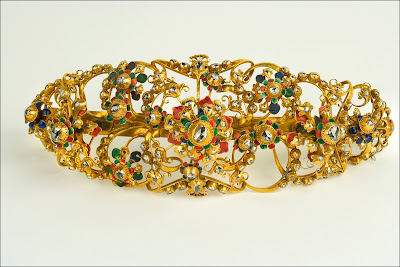
Hair Ornament - Observe a piece of fashion history from the late 18th century while viewing this elaborate Spanish hair ornament made of gold, carbonized steel, diamonds, and guilloché with transparent enamel.
Photo by Roderick Mickens © American Museum of Natural History
Here's a A Walk Through of the Exhibition
Described as stunning, elegant, regal, unyielding, and pure, diamonds
have inspired scientists, writers and artisans for thousands of years. The Nature of Diamonds explores the human fascination with diamond and its cultural and scientific importance. Seven exhibition sections delve into many aspects of diamond including its geological origins, how it’s mined, its cultural significance in art and adornment, and its numerous uses in modern technology. All this is set against a backdrop of stupendous gemstones and gems such as the 128.54-carat Tiffany Diamond – one of the world’s largest and finest fancy yellow diamonds.
What is Diamond?
In the exhibition’s first section, learn about diamond as the world’s hardest mineral and discover how old diamond truly is. Examine a hands-on model of the gem’s crystal structure and an interactive display demonstrating diamond’s remarkable ability to conduct heat. Watch how a prism disperses light into a rainbow of colors, creating a jewelry maker’s prized “fire.” Discover how diamond’s brilliance and sparkle come from refraction – the ability to scatter and reduce the speed of light passing through the crystal. An extensive variety of diamond specimens, as found in nature, demonstrate the mineral’s diversity and highlight the dazzling beauty that has led to its legendary status.
The Source of Diamonds on Earth
Most diamonds formed about 3.3 billion years ago, hundreds of miles within the Earth’s molten mantle, although there are a few “youngsters” only about 100 million years old. This section illustrates how diamonds are hurled up
from deep within the Earth by the action of explosive volcanoes that create “diamond pipes.” Walk through a recreated pipe where rarely seen samples of diamond still embedded in kimberlite (volcanic rock) are displayed. At the end of the pipe, a large-screen video illustrates the source of diamond and shows how it explodes to the surface. The most recent kimberlite eruption was about 53 million years ago, just a few ticks of the geological clock.
Historical Galleries
This section illuminates the rich cultural and historical importance of diamond. The gallery presents an historical panorama of diamond legend and lore. Ancient and medieval jewelry, manuscripts, and artifacts demonstrate how diamonds moved from India to the West.
A magnificent selection of jewelry from the 15th through 19th centuries, as well as an impressive collection of diamond betrothal rings, shows the role diamonds have played in personal adornment. The elaborate dress of the upper classes in 16th and 17th centuries is illustrated by a portrait of Marie de Medici, (1573-1642), second wife of Henry IV of France. She is shown wearing a bodice ornament set with diamonds and pearls; diamonds also are sewn into her dress and adorn her hair.
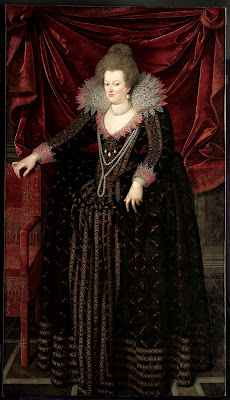
This portrait of Marie de Medici (Queen of France, 1573-1642, second wife of Henry IV of France) depicts the Queen wearing a complex bodice ornament of diamonds and pearls. Also, to show off her royal status, diamonds are sewn into her dress and adorn her hair. Photo by Roderick Mickens © American Museum of Natural History
An assortment of historically significant artifacts loaned by the Hispanic Society of America is also showcased here. Many of these objects have never been on loan before and have not been seen in public for 50 years. The Virgin of the Immaculate Conception brooch (first half of the 1600s) depicts the Virgin Mary in a frame of fleur-de-lis and four table-cut diamonds. A more elaborate rendering, Virgin of the Pillar (late 1600s), is set with table-cut diamonds and rubies that frame the enameled figures of the Virgin and the Christ Child.
Fast forward to modern times and discover how diamond's connotation of class, culture, and wealth captured the heart of Hollywood. Here are pieces worn by actresses of yesterday and today, including a diamond bracelet owned by Joan Crawford, a brooch based on a palm reader’s diagram created for Joan Bennett, and a tiara worn by Selma Hayek.
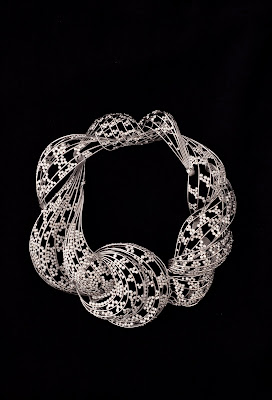
“Milky Way” Necklace
This voluminous necklace, designed for Brinkhause Jewelers, is adorned with 2,000 luminous diamonds. The Milky Way necklace was designed in 2000 as a celebration and ode to the millennium. Photo © Phillip Hersee Photography Ltd.
Other captivating pieces in this section include a charming gecko brooch with “skin” made of 1,524 green diamonds (62.16 carats) – the creature looks ready to leap to life. Frank Gehry’s Diamonds in the Rough necklace demonstrates the architect’s fascination with form, texture, and movement. He shaped 18-carat white gold mesh into which he sewed fancy gray, pink, and brown diamonds.
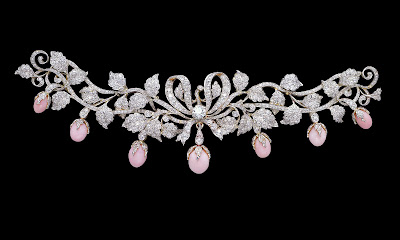
Rosebud Bodice Ornament
This bodice ornament, fashioned by Tiffany & Co., is made of radiant diamonds, set in platinum backed in gold, and adorned with seven conch pearl rosebuds. Courtesy Tiffany & Co. Archives
To prove that diamonds are more than a ‘girl’s best friend,’ take a look at the handsome Toronto Maple Leaf’s Stanley Cup ring, made in 1992 and presented to sports writer Milt Dunnell to commemorate the 1967 Stanley Cup championship.
Representing 21st century design is the magnificent Tip of the Iceberg ring with a natural uncut 2.87-carat eight-sided diamond intended to represent Canada’s rugged landscape. The stone came from the Ekati mine in the Northwest Territories, Canada’s first diamond mine.
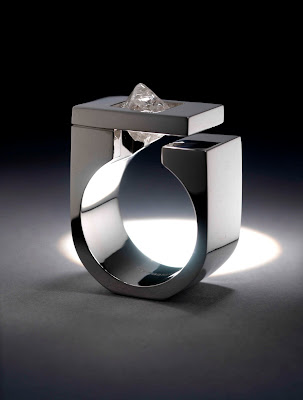
“Tip of the Iceberg” Ring - Chosen for its resemblance to the landscape of Canada, this ring is noted for its unorthodox construction. The setting creates the illusion that the uncut diamond appears to be magically floating within the ring. Photo © Royal Ontario Museum, 2008
Diamond Exploration and Mining
In this section of the exhibition, discover the different types of mining and diamond’s progression from mine to dealer. Learn about the English businessman and financier Cecil Rhodes (1853-1902) who founded the modern diamond industry. As a teenager, Rhodes was sent to South Africa to heal his asthma. There, he began purchasing diamond claims and created what eventually became the world’s largest diamond company.
This section of the exhibition also explores how diamonds are mined in North America. A video about the Canadian Mining Industry recounts the story of how, since the opening of the Ekati Mine in 1998, the country has quickly become the world’s third-largest diamond producer by value.
The Vault
A walk-in vault at the center of the exhibition houses many of the exhibition’s most dazzling objects. Included in this stunning display is a corsage pin made of 2,637 Brazilian diamonds (136 carats). It was created in 1855 for Princess Mathilde, niece of Napoleon Bonaparte I, and later was owned by Mrs. Cornelius Vanderbilt.
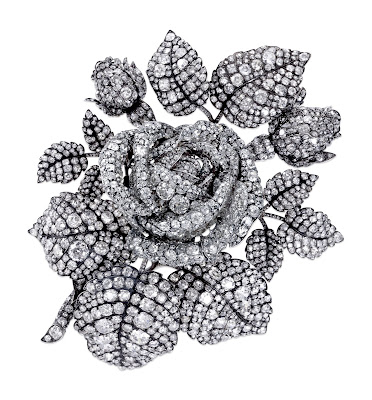
Princess Mathilde Corsage Ornament
This six-inch rose was crafted in 1855 for Princess Mathilde, niece of Napoleon I. It is made of 2,637 sparkling Brazilian diamonds. © Siegelson Collection
The delicate Question Mark necklace (1890) was created by the famed French House of Boucheron, noted for its royal clients. A single flower at the end of a graceful curve forms a sweeping question mark around the wearer’s neck.
A voluminous neckpiece that swathes the wearer in jewels, the Milky Way necklace has 2,000 diamonds (67.96 carats) suspended in a platinum grid. This boldly eccentric design, was made in the year 2000 as a salute to the millennium.
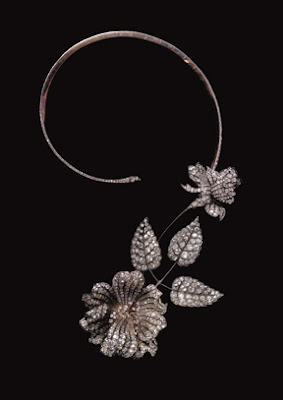
Question Mark Necklace
This necklace, a single dramatic flower at the end of a sweeping curve, was created by the House of Boucheron in 1890. This French jewelry house is an international leader for high-end jewelry and is famous for its royal and celebrity clients. Photo by Katharina Faerber © Thos. Faerber
A highlight of The Vault is the dazzling Incomparable Diamond. This gold colored kite-shaped diamond was graded as flawless by the Gemological Institute of America. It was found as an 890-carat rough diamond in the early 1980s. Following four years of study and cutting, the 407.48-carat diamond emerged; it is the third-largest cut diamond ever recorded.
The Four Cs
This section informs the visitor that cut, carat, color, and clarity are the standards by which diamonds are judged as gemstones. A video, From Rough Cut to Cut Gem, shows the many ways a raw diamond is transformed into a gemstone.
Recently, a new, fifth “C” has been added to the list: certification. The exhibition explains the Kimberly Process that was instituted in 2003 to help staunch the flow of conflict diamonds, also known as “blood diamonds.” Today, 74 countries participate in the Kimberly Process, whereby they pledge not to traffic in conflict gems.
Diamonds in Industry, Science, and Technology
The final section demonstrates how diamond is uniquely suited for applications in science and technology, and how recent breakthroughs in synthetic diamonds have facilitated their widespread use. This part of the exhibition features displays of large diamond saws, oil-well drills, and implements to cut marble countertops and automobile parts.
Visitors will discover how a diamond scalpel is resistant to becoming wet, making it invaluable as a surgical knife in that it cuts cleanly. “One-hour eyeglasses” became possible with the use of diamond tools that can quickly and accurately shape lenses. Because diamonds withstand extremely high temperatures and corrosive conditions, they are ideal for use in industry and in space probes. Every wire in a computer, television and house has been shaped by a dye made from diamond.
Diamond has even been to Mars; on display is a model of the RAT (Rock Abrasion Tool) used on the Mars Rover which was equipped with diamond bits to drill through the surface of Mars to collect samples. A number of such applications make it clear that diamond’s future role in technology and industry is both boundless and intriguing.
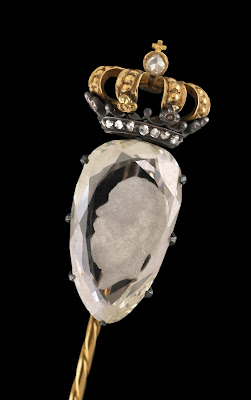
Diamond Stick Pin
This diamond pin, carved in the late 19th century, shows an intricate portrait of King Willem III of the Netherlands. The pin took five years to create,
using delicate diamond-tipped tools. Photo © 2009 The Field Museum
DETAILS on The Nature of Diamonds
Exhibition Dates: October 23, 2009 through March 28, 2010
Overview: Discover the dual nature of diamonds – at once glittering and tough, decorative and utilitarian. The exhibition showcases nearly 800 items, including breathtaking gems. It features the crème de la crème of designers such as Tiffany& Co., Van Cleef & Arpels, Boucheron, and Cartier. Explore subjects such as earth science, diamond mining, and industrial uses of diamond to complete the story of this fascinating and important mineral.
Location: The Field Museum
1400 S. Lake Shore Drive, Chicago, IL 60605-2496
Contact: 312.922.9410 General Field Museum Information
Organizer: The Nature of Diamonds is organized by the American Museum of Natural History, New York, in collaboration with The Field Museum, Chicago; the Royal Ontario Museum, Toronto; and the Houston Museum of Natural Science.
Sponsor: This exhibition is made possible by the generous support of
The Grainger Foundation of Lake Forest.
Admission and Tickets to The Nature of Diamonds include Basic admission to The Museum
Hours: Field and Museum and are priced at $23 for adults, $20 for seniors and students with ID, and $13 for children 3-11. Discounts are available for Chicago residents. Visit fieldmuseum.org or call 866.FIELD.03. Special rates are available for tour operators and groups of 15 or more. Call our Group Sales office toll-free at 888.FIELD.85 (888.343.5385).
Open every day from 9am to 5pm (last admission is 4 pm). Closed on Christmas Day.
Feature Photo: Raw Diamond in Matrix
Visitors to The Nature of Diamonds will see what a newly discovered and untouched diamond looks like, from deep within the Earth, as formed billions of years ago. Photo © 2009 The Field Museum
All photos and information courtesy and copyright The Field Museum.
NOTE: We were guests of the Field Museum on our recent visit.
-

- Log in to post comments



















